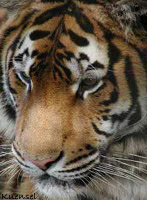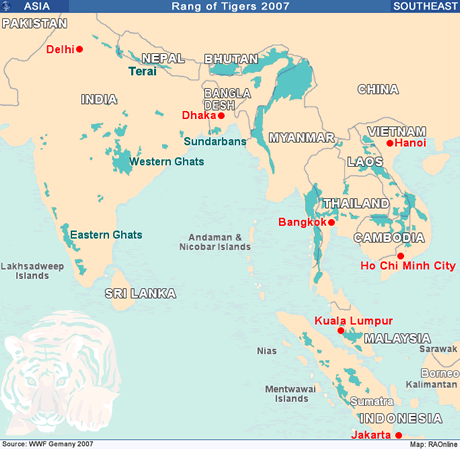| Bhutan's
Nature - Animals |
 |
Bhutan Nature Animals |
|
 |
Bhutan Information |
|
|
 |
|
Sub-tropical
Royal Bengal Tigers move above 3000m
|
 |
 |
| Sub-tropical Royal Bengal Tiger |
| Bhutan
could be the first country in the world to record a credible account of
the movement of the Royal Bengal Tigers from their sub-tropical habitat to elevation as high as the tree line area, according to the findings of
the Nature Conservation Division (NCD) of the Ministry of Agriculture.
The
findings could contradict many Tiger experts around the world who believed
that the Royal Bengal Tigers (panthera tigris tigris) found in India, Bangladesh
and Nepal besides Bhutan, moved mainly in tropical and sub-tropical regions
at sea level to sometimes as high as 2600 metres above sea level but never
beyond. |
|
This
week a NCD survey team clinched a new fact that the tigers moved beyond
3,000 metres. Remains of two horses, one cow and two mithun breed cows were
found near a ridge between Thimphu dzongkhag and Punakha dzongkhag, three
hours walk above Dodeyna which is about 15 kilometres from the Thimphu
town, whose evidences showed that the kill was made by the Royal Bengal
Tigers. The actual site showed 3,400 metres above sea level.
 |
|
According
to NCD's joint director, Dr. Sangay Wangchuk, who was also part of the
survey team, the nature of the kill especially the large canine mark on
the livestock's necks and pug mark on the earth were evident of the tiger's
attack. The NCD team also concluded that four tigers- a male and a female
with two cubs- lived in the area.
"This is the first time in Bhutan where
solid evidences has been collected of the movement of tigers above 3,000
metres," Dr. Sangay Wangchuk said.
The finding also indicated for the first
time the use of the biological corridor by tigers to move from one park
to another, he said.
|
|
Bhutan
has about 10 biological corridors established chiefly for the movement
of tigers which covers nine percent of the country's area and which connects
wildlife parks from Manas to the Jigme Dorji National Park covering
another 26 percent of the country.
The
presence of tigers was, however, reportedly sighted by the Bhutanese farmers
in the past in places above 4,000 metres. A tiger was even caught by a camera
at 2,900 metres in Thrumshingla National Park few years back. Studies
pointed out that the total number of tigers found in Bhutan was between
115 to 150 and was distributed from west to east- Jigme Dorji National
Park to Bumdeling Wild Life Sanctuary via Jigme Singye Wangchuck National
Park and Thrumshingla National Park. The tigers were also found in Manas and Sarpang in the south.
Meanwhile,
NCD officials said that the farmers who lost their livestock to tigers
in Dodeyna would be compensated- Nu. 5,500 each for the two mithun breed
cows, Nu. 6,000 each for the two horses, and Nu. 5,000 for the cow. According
to NCD a Tiger Conservation Fund was established last year to compensate
farmers who lost their livestock to tigers, leopard, snow leopards and
bears, the four of which were protected by Bhutan's Forest and Nature
Conservation Act 1995. Killing tigers entailed heavy legal prices in
Bhutan.
With
the disbursement of the money to Dodeyna farmers, the government would
have compensated 181 farmers with payment of Nu. 1.2 million from the Tiger
Conservation Fund. Studies pointed out that Bhutanese farmers lost
substantial number of livestock to tigers every year. NCD recorded 218
livestock that were killed by tigers between 1999 and 2001.
| Contributed
by Kencho Wangdi, KUENSEL, Bhutan's National Newspaper |
 |
top
| Wildlife and People in Bhutan |
 |
| Information on Bhutan |
 |
| Links |
 |
 |
 |
External
links |
|
|




